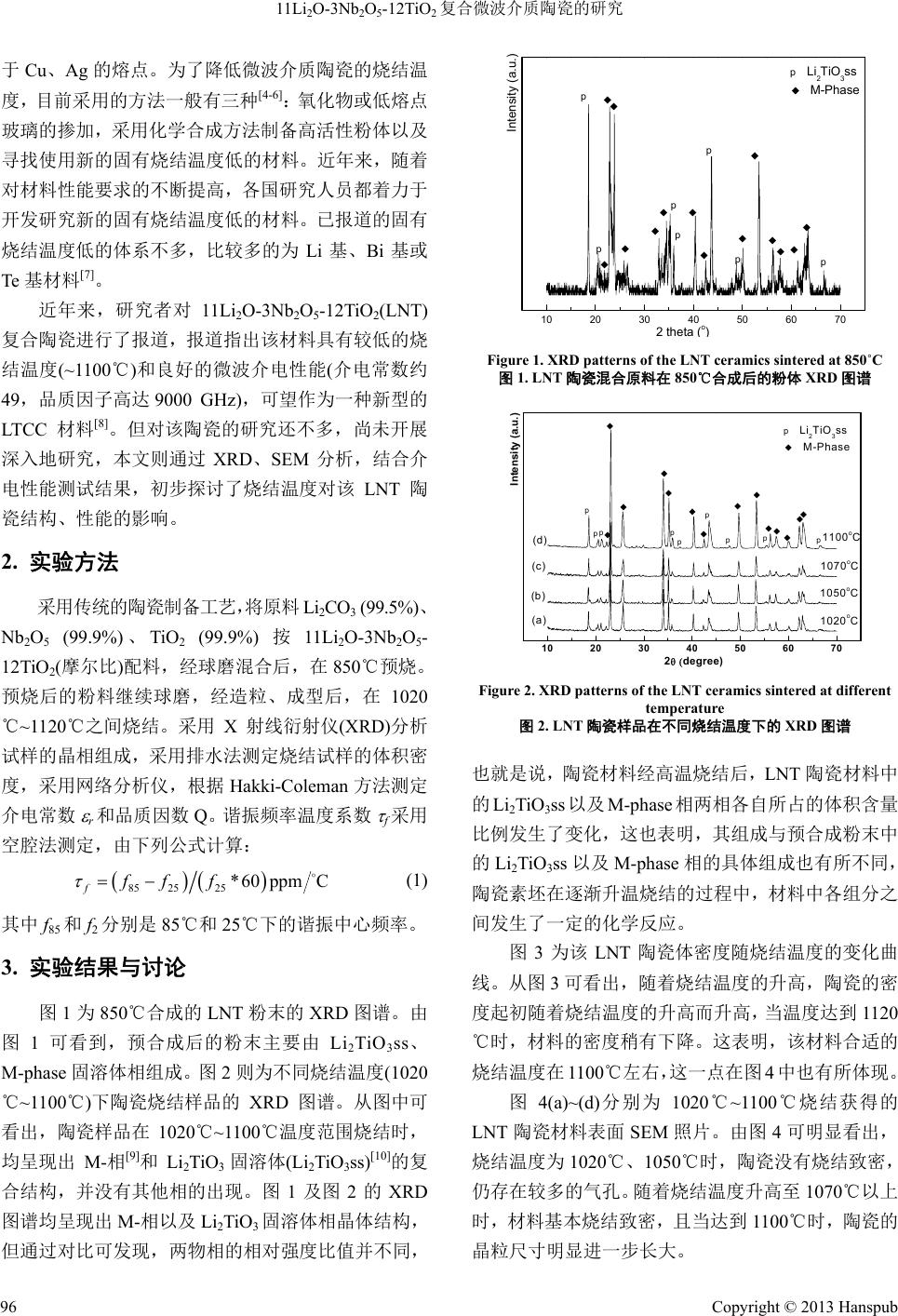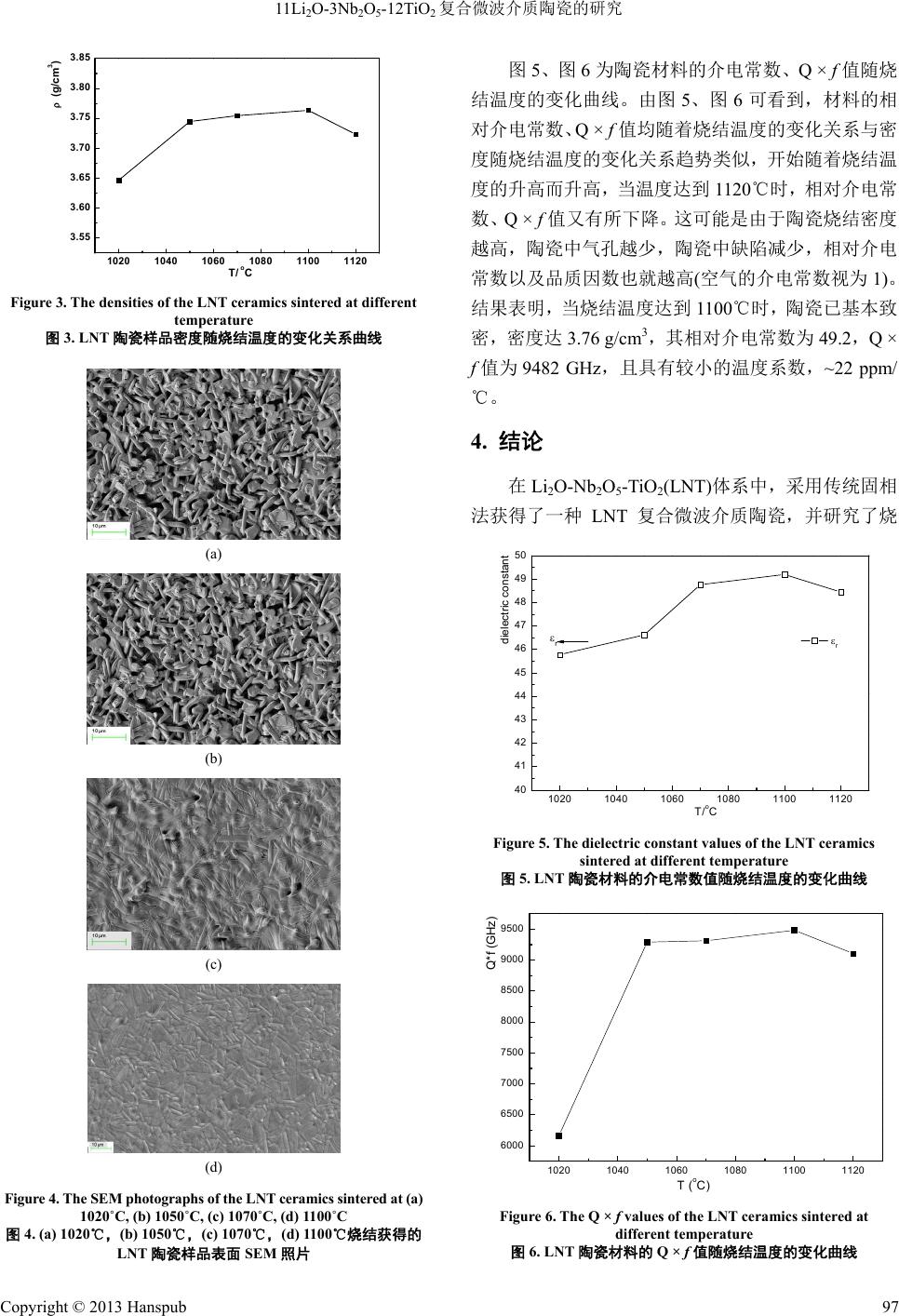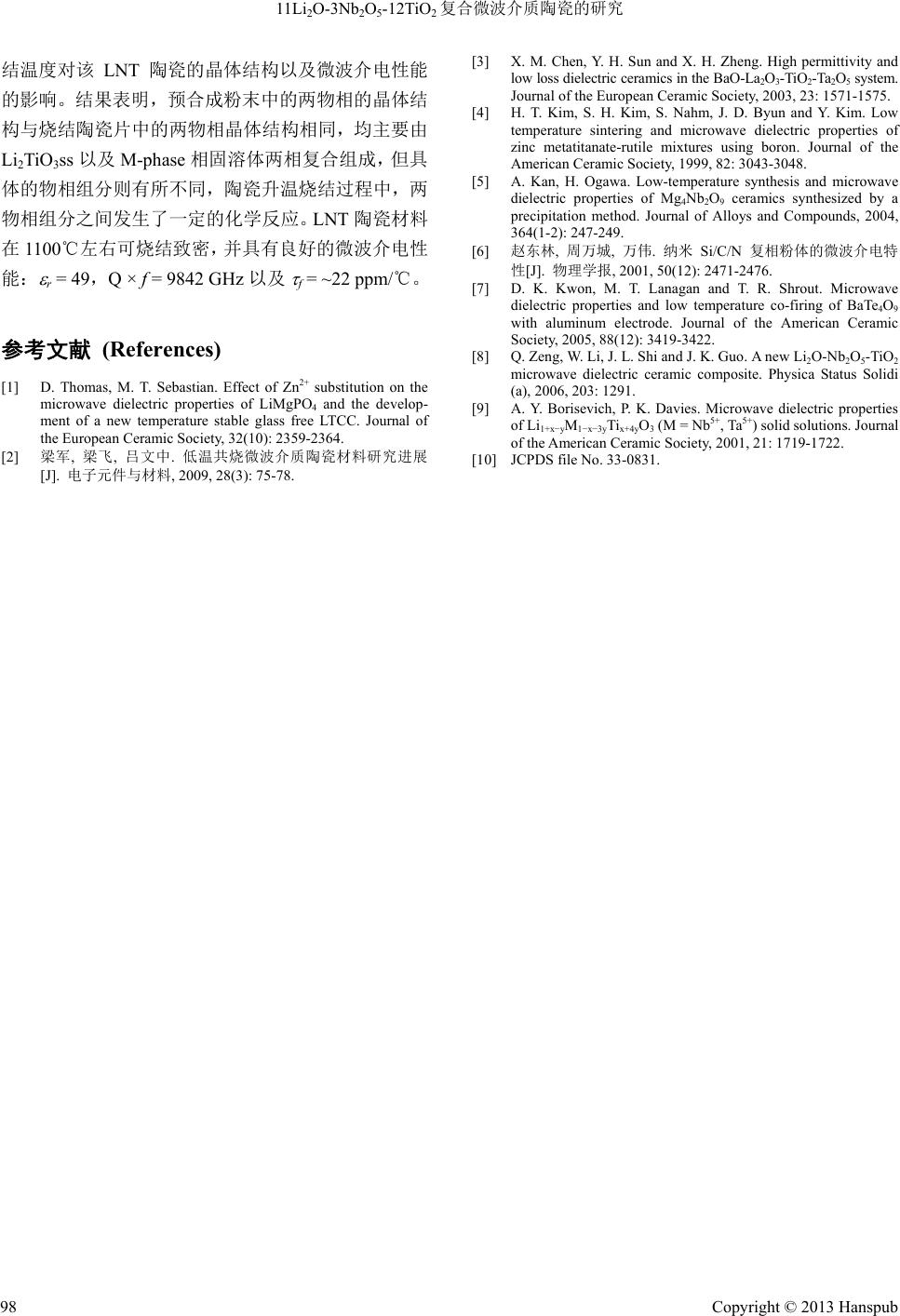 Material Sciences 材料科学, 2013, 3, 95-98 http://dx.doi.org/10.12677/ms.2013.32018 Published Online March 2013 (http://www.hanspub.org/journal/ms.html) Study of the 11Li2O-3Nb2O5-12TiO2 Microwave Dielectric Ceramic Composite* Dan Li1, Qun Zeng2#, Nana Zhang2 1Guangzhou Crystal Technology Co., Ltd.¸ Guangzhou 2Key Laboratory of Nanophotonic Functional Materials and Devices in Guangdong Province, South China Normal University, Guangzhou Email: #qunzeng@scnu.edu.cn Received: Dec. 17th, 2012; revised: Jan. 23rd, 2013; accepted: Feb. 11th, 2013 Abstract: The 11Li2O-3Nb2O5-12TiO2(LNT) microwave dielectric ceramic composites have been prepared by the solid-state reaction method. The effects of the sintering temperature on phase structure and properties were investigated by XRD, SEM and the measured dielectric properties. The calcined powders at 850˚C and the dense ceramics were mainly composed of Li2TiO3ss and M-phase solid solution. No other phase structure could be found in the dense LNT ceramics. And the compositions of two phases in the dense ceramics are different from those in the calcined powders. The LNT ceramics could be sintered densely at 1100˚C with density of about 3.76 g/cm3 and good microwave dielectric properties of r = 49, Q × f = 9842 GHz and f = −22 ppm/˚C. Keywords: Microwave Dielectric Properties; 11Li2O-3Nb2O5-12TiO2 11Li2O-3Nb2O5-12TiO2复合微波介质陶瓷的研究* 李 丹1,曾 群2#,张娜娜 2 1广州晶体科技有限公司,广州 2华南师范大学广东省微纳光子功能材料与器件重点实验室,广州 Email: #qunzeng@scnu.edu.cn 收稿日期:2012 年12 月17日;修回日期:2013 年1月23 日;录用日期:2013年2月11 日 摘 要:本文采用传统固相法制备了11Li2O-3Nb2O5-12TiO2(LNT)复合微波介质陶瓷,通过 XRD、SEM 分析手 段,结合介电性能测试结果,探讨了烧结温度对材料相结构、介电性能的影响。结果表明,原料粉末经 850℃ 预合成后,主要生成 Li2TiO3ss 以及 M-phase 固溶体。致密陶瓷片主要由 Li2TiO3ss 与M-phase固溶体两相复合 组成,并没有其他相结构存在。陶瓷片中两相的组分与预合成粉末中两相的组分并不同。烧结温度达 1100℃时, 陶瓷片烧结致密,密度达 3.76 g/cm3,相对介电常数达49,Q × f值为 9482 GHz,且具有相当小的温度系数, f = ~22 ppm/℃。 关键词:介电性能;复合微波介质陶瓷 1. 引言 近年来,随着现代移动通讯设备不断朝着微型 化、片式化、低成本和环保的方向发展,以发展能与 高电导率的低熔点贱金属Cu、Ag或Cu/Ag 合金共烧 的低温共烧陶瓷(Low Temperature Co-fired Ceramic, 简称 LTCC) 成为微波介质材料发展的主流[1]。作为 LTCC材料,除了要求具有良好的微波介电性能,还 要求其能在不高于 Cu 或Ag 电极的熔点温度(分别为 1064℃和 961℃)下烧结致密[2]。但是,目前商业微波 介质陶瓷的烧结温度多在 1300℃~1500℃[3],远远高 *资助信息:国家青年科学基金(NO. 51102100)资助项目。 #通讯作者。 Copyright © 2013 Hanspub 95  11Li2O-3Nb2O5-12TiO2复合微波介质陶瓷的研究 于Cu、Ag 的熔点。为了降低微波介质陶瓷的烧结温 度,目前采用的方法一般有三种[4-6]:氧化物或低熔点 玻璃的掺加,采用化学合成方法制备高活性粉体以及 寻找使用新的固有烧结温度低的材料。近年来,随着 对材料性能要求的不断提高,各国研究人员都着力于 开发研究新的固有烧结温度低的材料。已报道的固有 烧结温度低的体系不多,比较多的为 Li基、Bi 基或 Te 基材料[7]。 近年来,研究者对11Li2O-3Nb2O5-12TiO2(LNT) 复合陶瓷进行了报道,报道指出该材料具有较低的烧 结温度(~1100℃)和良好的微波介电性能(介电常数约 49,品质因子高达 9000 GHz),可望作为一种新型的 LTCC材料[8]。但对该陶瓷的研究还不多,尚未开 展 深入地研究,本文则通过 XRD、SEM 分析,结合介 电性能测试结果,初步探讨了烧结温度对该 LNT 陶 瓷结构、性能的影响。 2. 实验方法 采用传统的陶瓷制备工艺,将原料 Li2CO3 (99.5%)、 Nb2O5 (99.9%)、TiO2 (99.9%) 按11Li2O-3Nb2O5- 12TiO2(摩尔比)配料,经球磨混合后,在850℃预烧。 预烧后的粉料继续球磨,经造粒、成型后,在 10 20 ℃~1120℃之间烧结。采用 X射线衍射仪(XRD)分析 试样的晶相组成,采用排水法测定烧结试样的体积密 度,采用网络分析仪,根据Hakki-Coleman 方法测定 介电常数 r和品质因数Q。谐振频率温度系数 f采用 空腔法测定,由下列公式计算: 852525 *60 ppmC fff f (1) 其中 f85和f2分别是 85℃和25℃下的谐振中心频率。 3. 实验结果与讨论 图1为850℃合成的 LNT 粉末的 XRD 图谱。由 图1可看到,预合成后的粉末主要由Li2TiO3ss、 M-phase 固溶体相组成。图 2则为不同烧结温度(1020 ℃~1100℃)下陶瓷烧结样品的 XRD图谱。从图中可 看出,陶瓷样品在1020℃~1100℃温度范围烧结时, 均呈现出M-相[9]和Li2TiO3固溶体(Li2TiO3ss)[10]的复 合结构,并没有其他相的出现。图1及图 2的XRD 图谱均呈现出M-相以及 Li2TiO3固溶体相晶体结构, 但通过对比可发现,两物相的相对强度比值并不同, 10 20 30 40 50 60 70 p p p p p p p Intensity (a.u.) 2 the ta ( o ) pLi2TiO3ss M-Phase Figure 1. XRD patterns of the LNT ceramics sintered at 850˚C 图1. LNT陶瓷混合原料在 850℃合成后的粉体 XRD 图谱 10 20 30 40 50 60 70 p p p p p p p p p 1100oC 1070oC 1050oC 1020oC (d) (c) (b) Intensity (a.u.) 2degree) (a) pLi2TiO3ss M -Pha s e Figure 2. XRD patterns of the LNT ceramics sintered at different temperature 图2. LNT陶瓷样品在不同烧结温度下的 XRD 图谱 也就是说,陶瓷材料经高温烧结后,LNT陶瓷材料中 的Li2TiO3ss 以及 M-phase 相两相各自所占的体积含量 比例发生了变化,这也表明,其组成与预合成粉末中 的Li2TiO3ss 以及 M-phase 相的具体组成也有所不同, 陶瓷素坯在逐渐升温烧结的过程中,材料中各组分之 间发生了一定的化学反应。 图3为该 LNT 陶瓷体密度随烧结温度的变化曲 线。从图 3可看出,随着烧结温度的升高,陶瓷的密 度起初随着烧结温度的升高而升高,当温度达到 1120 ℃时,材料的密度稍有下降。这表明,该材料合适的 烧结温度在 1100℃左右,这一点在图4中也有所体现。 图4(a)~(d)分别为1 020℃~1100℃烧结获得的 LNT 陶瓷材料表面 SEM 照片。由图 4可明显看出, 烧结温度为 1020℃、1050℃时,陶瓷没有烧结致密, 仍存在较多的气孔。随着烧结温度升高至1070℃以上 时,材料基本烧结致密,且当达到1100℃时,陶瓷的 晶粒尺寸明显进一步长大。 Copyright © 2013 Hanspub 96  11Li2O-3Nb2O5-12TiO2复合微波介质陶瓷的研究 1020 1040 1060 1080 1100 1120 3.55 3.60 3.65 3.70 3.75 3.80 3.85 (g/cm3) T/ oC Figure 3. The densities of the LNT ceramics sintered at different temperature 图3. LNT陶瓷样品密度随烧结温度的变化关系曲线 (a) (b) (c) (d) Figure 4. The S EM phot o grap h s of th e LNT c eram ics sint e r ed at (a) 1020˚C, (b) 1050˚C, (c) 1070˚C, (d) 1100˚C 图4. (a) 1020℃,(b) 1050℃,( c) 1070℃,(d) 1100℃烧结获得的 LNT 陶瓷样品表面 SEM 照片 图5、图 6为陶瓷材料的介电常数、Q × f值随烧 结温度的变化曲线。由图 5、图 6可看到,材料的相 对介电常数、Q × f值均随着烧结温度的变化关系与密 度随烧结温度的变化关系趋势类似,开始随着烧结温 度的升高而升高,当温度达到 1120℃时,相对介电常 数、Q × f值又有所下降。这可能是由于陶瓷烧结密度 越高,陶瓷中气孔越少,陶瓷中缺陷减少,相对介电 常数以及品质因数也就越高(空气的介电常数视为1)。 结果表明,当烧结温度达到 1100℃时,陶瓷已基本致 密,密度达 3.76 g/cm3,其相对介电常数为49.2,Q × f值为 9482 GHz,且具有较小的温度系数,~22 ppm/ ℃。 4. 结论 在Li2O-Nb2O5-TiO2(LNT)体系中,采用传统固相 法获得了一种 LNT 复合微波介质陶瓷,并研究了烧 1020 1040 1060 1080 1100 1120 40 41 42 43 44 45 46 47 48 49 50 r T/oC dielectric constant r Figure 5. The dielectric constant values of the LNT ceramics sintered at different temperature 图5. LNT陶瓷材料的介电常数值随烧结温度的变化曲线 1020 1040 1060 1080 1100 1120 6000 6500 7000 7500 8000 8500 9000 9500 Q*f (GHz) T (oC) Figure 6. The Q × f values of the LNT ceramics sintered at different temperature 图6. LNT陶瓷材料的 Q × f值随烧结温度的变化曲线 Copyright © 2013 Hanspub 97  11Li2O-3Nb2O5-12TiO2复合微波介质陶瓷的研究 Copyright © 2013 Hanspub 98 结温度对该 LNT 陶瓷的晶体结构以及微波介电性能 的影响。结果表明,预合成粉末中的两物相的晶体结 构与烧结陶瓷片中的两物相晶体结构相同,均主要由 Li2TiO3ss 以及 M-phase 相固溶体两相复合组成,但具 体的物相组分则有所不同,陶瓷升温烧结过程中,两 物相组分之间发生了一定的化学反应。LNT陶瓷材料 在1100℃左右可烧结致密,并具有良好的微波介电性 能: r = 49,Q × f = 9842 GHz 以及 f = ~22 ppm/℃。 参考文献 (References) [1] D. Thomas, M. T. Sebastian. Effect of Zn2+ substitution on the microwave dielectric properties of LiMgPO4 and the develop- ment of a new temperature stable glass free LTCC. Journal of the European Ceramic Society, 32(10): 2359-2364. [2] 梁军, 梁飞, 吕文中. 低温共烧微波介质陶瓷材料研究进展 [J]. 电子元件与材料, 2009, 28(3): 75-78. [3] X. M. Chen, Y. H. Sun and X. H. Zheng. High permittivity and low loss dielectric ceramics in the BaO-La2O3-TiO2-Ta2O5 system. Journal of the European Ceramic Society, 2003, 23: 1571-1575. [4] H. T. Kim, S. H. Kim, S. Nahm, J. D. Byun and Y. Kim. Low temperature sintering and microwave dielectric properties of zinc metatitanate-rutile mixtures using boron. Journal of the American Ceramic Society, 1999, 82: 3043-3048. [5] A. Kan, H. Ogawa. Low-temperature synthesis and microwave dielectric properties of Mg4Nb2O9 ceramics synthesized by a precipitation method. Journal of Alloys and Compounds, 2004, 364(1-2): 247-249. [6] 赵东林, 周万城, 万伟. 纳米 Si/C/N 复相粉体的微波介电特 性[J]. 物理学报, 2001, 50(12): 2471-2476. [7] D. K. Kwon, M. T. Lanagan and T. R. Shrout. Microwave dielectric properties and low temperature co-firing of BaTe4O9 with aluminum electrode. Journal of the American Ceramic Society, 2005, 88(12): 3419-3422. [8] Q. Zeng, W. Li, J. L. Shi and J. K. Guo. A new Li2O-Nb2O5-TiO2 microwave dielectric ceramic composite. Physica Status Solidi (a), 2006, 203: 1291. [9] A. Y. Borisevich, P. K. Davies. Microwave dielectric properties of Li1+x−yM1−x−3yTi x+4yO3 (M = Nb5+, Ta5+) solid solutions. Journal of the American Ceramic Society, 2001, 21: 1719-1722. [10] JCPDS file No. 33-0831. |